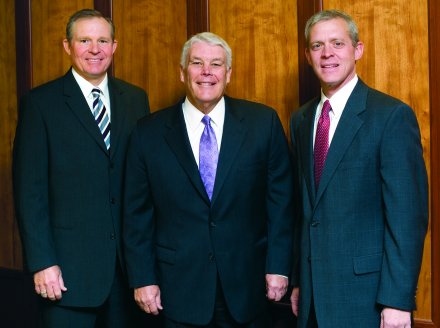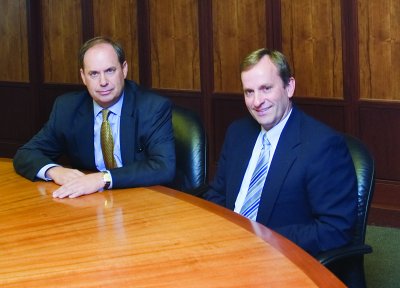
and Bill Tingey, Chief Financial Officer, Moreton & Company.
Capitalizing on Benefits
MOVING BEYOND SALES
Value-added services is the key to growing Moreton's benefits area (or division?)
By Len Strazewski
"In the past, the insurance carriers were the key providers of service...Today, the broker provides most of the services related to benefits, with the carriers as only one piece of the puzzle."
--Bill Moreton
President
Moreton & Company
Health care reform may transform the way Americans receive health benefits from their employers, but don't expect health insurance to disappear--or claims costs to trend down. And employee benefits-related service will be in more demand, not less.
Gone are the days when brokers placed employers with health insurance companies and walked away for a year, says Bill Moreton, president of Moreton & Company in Salt Lake City, Utah.
Service is the now the value proposition for brokers who specialize in employee benefits and no matter how health care reform resolves, employers will need more and better service from their brokers to understand and manage their future, he explains "In the past, the insurance carriers were the key providers of service and the brokers were the individuals who connected the clients to the appropriate carriers. Today, the broker provides most of the services related to benefits, with the carriers as only one piece of the puzzle," Bill explains.
"Employers turn to their brokers for help with the plan design, tough claims, and educating their employees about enrollment. When they need guidance about the latest laws and regulations, we are where they turn."
Moreton was founded in 1910 and has grown into one of the largest privately owned insurance brokerages in the Intermountain West area, executives say. The firm has more than 175 employees in three divisions in Salt Lake City; Boise, Idaho; and Denver, Colorado, generating an annual premium volume of more than $600 million.
The brokerage has about 60 employees in its employee benefits operations which generate about 40% of total revenues.

|
| Moreton executives include (from left): Earl Hurst, Executive Vice President, Moreton of Utah; Craig Smith, President, Moreton of Utah; and Bill Tingey, Chief Financial Officer, Moreton & Company. |
Like many insurance agents and brokers, Moreton began as a property/casualty insurance agency, focused on mining and related industries in the western region of the United States, providing life insurance sales as an accommodation. In the late 1970s and early 1980s, the firm expanded into employee benefits, Bill recalls, hiring its first dedicated benefits producer.
Since then, benefits has been one of the fastest growing aspects of the company and it is still trending upward as rates steadily increase.
Bill declines to set a target for future benefit revenues. "We'll take the revenue wherever we can get it," he says, "We're trying to grow all of our business." But a day when employee benefits sales accounts for half or more of the firm's totals is foreseeable if present soft property/casualty rate trends continue.
Craig Smith, president of Moreton's Utah office, joined the brokerage 22 years ago and has watched the evolution of the firm from a traditional insurance sales organization to a comprehensive service provider. "Our role is to assist the client in whatever ways possible. Our first job is understanding our clients' long-term business strategies and then helping them design employee benefits strategies that are consistent with their needs. "
Craig says Moreton clients vary in size among the firm's regional offices with more small businesses in Idaho and larger employers in metropolitan Denver. While the brokerage serves many small businesses with two to 99 employees, Smith says it can provide more sophisticated approaches to larger employers with 100 or more employees and targets employers with 100 to 350 employees who can benefit most from the firm's services.
These techniques can include self-funding all or part of group health costs, which provides employers with greater insight into claims trends, consumer-directed health plans (CDHPs) that give employees more responsibility for choosing affordable care, and wellness programs which encourage more healthful lifestyles, he says.
Earl Hurst joined Moreton's Utah office in August as executive vice president and adds another level of health industry perspective. Hurst has 30 years of experience in health and insurance services and formerly was president of Humana's Utah operations.
He says the future of health care cost control isn't imore managed care from group health plans, but rather greater transparency in the actual cost of care and more sophisticated decisions by health care consumers with a financial motivation to choose wisely.

|
| Mark Davis (left) and Matt DeWaal wear several hats at Moreton. Both are Executive Vice Presidents and Benefits producers at the firm. |
"Few plan participants really know the actual cost of their medical care. Until recently, the only communication most employees had with their health plan has been the Explanation of Benefits (EOB) form they receive after claims have been paid," Earl notes. "There has been no transparency in the actual costs of medical procedures and the knowledge that the cost may vary among medical service providers."
However, as more employers introduce consumer-directed health plans such as health savings accounts (HSAs) and large deductible group plans, more employees are motivated to research the cost of their care and make personal consumer choices among care providers, he says.
The result has been more competitive pricing and a lower rate of cost increase among elective medical procedures. "Acute medical costs continue to increase at several times the rate of the CPI (Consumer Price Index) increase," an indication of runaway medical inflation, he says. "But employee-paid procedures such as cosmetic surgery and Lasik (vision improvement) surgery is tracking much closer to the CPI," reflecting more normal consumer product inflation.
According to the Moreton Web site, while the cost of employee-paid medical procedures such as cosmetic surgery has continued to increase, up 22% this year, the cost of procedures paid directly by employers has risen more than four times more--up 90% this year.
Matt DeWaal, senior vice president and benefits producer, says Moreton has been promoting CDHPs since their inception and he has noticed a significant change in the behavior of individuals who participate in the plans.
"Whatever the upfront account--whether its $500 or $2,000--the reality of the financial commitment makes you more involved in the whole process. When it's your money that you are paying, you pay more attention to what you are buying and what it costs," Matt explains.
CDHPs also provide a good platform for employee wellness programs, another approach that is gaining popularity among Moreton clients. Wellness programs, which can range from simple health incentives such as health club discounts and weight loss contests to blood tests for health screening, "give employers a chance to push back against the trend of rising costs," says Matt.
Moreton partners with local and national program providers as well as the leading group health plans to provide customized wellness programs for many of its clients, he says. "We will tap every resource available to give our clients the range of wellness services they want to be available to their employees."
The largest group health plans in the three-state market include: Cigna Health Humana, [no space] UnitedHealthcare, and Regence Blue Cross/BlueShield and Intermountain Healthcare, a regional provider network.
However, wellness programs are undergoing a transformation, adds Mark Davis, senior vice president and another benefits producer.
Most wellness programs were originally introduced by group health plans as an educational support program for their participants, he explains. "These were the carrots of the past, the rewards for participating in the programs.
"Now we are seeing more of the stick, as employers are building risk into the programs," he says.
These new wellness programs allow plan administrators to identify employees with risk factors such as obesity, high cholesterol, or high blood pressure and provide premium discounts--only if they meet health targets determined with health coaches.
Mark says Moreton has more than 100 employers participating in wellness programs that are showing measurable improvements in such measures as body mass index (BMI), blood pressure and cholesterol.
Matt DeWaal says employers continue to be concerned about the impact of health reform on their benefit plans, but he believes that while the rules and regulations "that are still on the burner" are unlikely to reduce costs on their own, they are also unlikely to affect the progress employers are making with their plan design and wellness program investments.

|
| "Few plan participants really know the actual cost of their medical care. Until recently, the only communication most employees had with their health plan has been the Explanation of Benefits (EOB) form." - Earl Hurst |
While health care reform and medical cost issues dominate the attention of Moreton benefits clients, employee benefit management and human resource management needs also remain important. In response to these needs, Bill Moreton notes that the brokerage also provides a full range of support services including online enrollment technology, human resource management consulting, benefits and human resources communications consulting.
"We are committed to helping our clients in whatever situations that affect their business," Bill notes. "This service approach has led us into expanding the resources we make available above and beyond traditional insurance. This approach, I believe, is unique to Moreton & Company in our region."
The Moreton staff includes an in-house employment attorney who provides management consulting on employment issues, contract reviews, and employee handbook policy language, compliance counseling on HIPAA, COBRA, FMLA, and training sessions on sexual harassment for both managers and employees.
This attorney also conducts quarterly client training sessions on human resource policies and procedures such as termination, downsizing and severance.
Moreton communications experts provide benefit information support including enrollment guides, employee benefit notices, education materials, posters, flyers and payroll stuffers.
The brokerage also provides other group and voluntary benefits including group dental and vision care plans, long- and short-term disability insurance, accidental death and dismemberment insurance, critical illness insurance, supplemental medical insurance and long-term care insurance.
The employee-paid voluntary benefits can also include non-medical benefits such as group auto and homeowners insurance, legal services and estate planning services through the agency's separate financial services company.